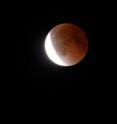Red moon at night; stargazer's delight
Monday night's lunar eclipse proved just as delightful as expected to those able to view it. On the East Coast, cloudy skies may have gotten in the way, but at the National Science Foundation's National Optical Astronomy Observatory (NOAO) near Tucson, Ariz., the skies offered impressive viewing. Nicknamed a "blood moon," this lunar eclipse's color was similar to the majority of lunar eclipses. This has to do with Earth's atmosphere's propensity for longer-wavelength light (e.g., the reds, oranges and yellows seen in sunrises and sunsets). However, according to NOAO Astronomer Stephen Pompea, the lunar eclipse's hue means more than just a pretty moon.
"The study of the color of lunar eclipses can be used to understand dust in the stratosphere including the amount and particle size of dust injected by volcanic eruptions," he said. "Understanding the amount of dust can help scientists create better models of climate change."
For those who missed this lunar eclipse, fear not. Three more are to occur fairly soon: Oct. 8, 2014; April 4, 2015 and Sept. 27, 2015.
Source: National Science Foundation
Articles on the same topic
- Red moon at night; stargazer's delightThu, 17 Apr 2014, 1:42:47 UTC
Other sources
- Red moon at night: Stargazer's delightfrom Science DailyThu, 17 Apr 2014, 0:32:26 UTC
- Red moon at night; stargazer's delightfrom PhysorgWed, 16 Apr 2014, 21:45:26 UTC


